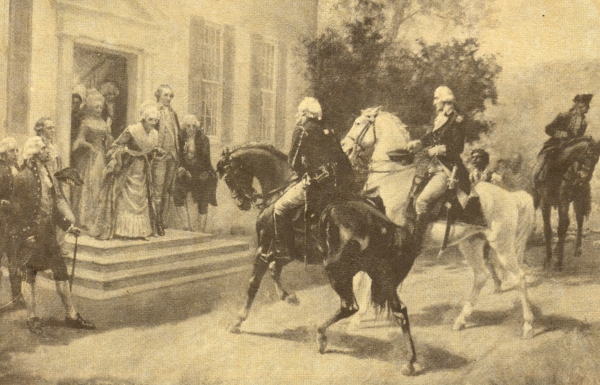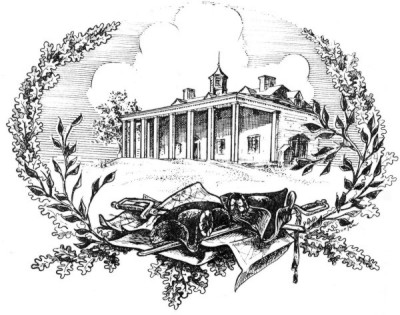TWO DAYS AT MOUNT VERNON
10-11 September 1781
|

|
|
Martha and General Washington welcome the visit of General comte de Rochambeau to Mount Vernon on 10 September 1781. This rather stylized depiction is believed to have been part of a series painted circa 1885 by J.L. Ferris. It was taken from an illustration in a Bicentennial booklet George Washington by Herman S. Fey.
The event took place during the strategic movement of the Allied Armies from positions in New York to Virginia, marking a significant moment in the Yorktown Campaign of 1781 when:
|

For two full days in September of 1781,
Mount Vernon was the
�Supreme Allied Headquarters'
for the Yorktown Campaign of 1781.

|
|
The Historic Significance:
During the two days of 10 through 11 September 1781 the allied generals, Washington and Rochambeau shared the same roof with their very close staffs. Reflection upon this unique, brief time span offers a special opportunity to focus on the most daring and essential components of the Yorktown Campaign that led to the Allied victory in October.
While many narrative histories of the Yorktown Campaign mention the Mount Vernon visit, the emphasis is understandably on the early September �Second Battle of the Virginia Capes' and the October siege of British defenses at York. The Allied Commanders' respite at Mount Vernon allows a window to appreciate the elusive, high risk, but essential components of the Yorktown Campaign. Such risks are illuminated when considering what the Allied Commanders had to have been thinking during those two days at Mount Vernon in September 1781. Reflecting on these two days provides a unique opportunity to focus on the separate parts of the campaign that had not -- at least in the commanders' minds -- yet come together.
The military situation at the time was as anxious as that facing Eisenhower waiting for the right weather to launch the D-Day Landing in Normandy. The Allied generals' September visit at Mount Vernon was celebrated during the Bicentennial, and deserves no less treatment for the 225th Anniversary of the Yorktown Campaign.
Very little was recorded that described the coalition commanders' actions while at Mount Vernon on 10 and 11 September 1781.
Rochambeau had to have been impressed with the spectacular setting of Mount Vernon on the Potomac. The scene must have reminded him of his ch�teau on the bank of the Loir River at Thor�-la-Rochette, near Vend�me, France. One could expect that George Washington would have been eager to have escorted the Comte about this plantation on the Potomac.
However, given the seriousness of the evolving military and naval situation to the south, it is unlikely that the Allied Commanders spent much time reminiscing about the tribulations of managing their respective estates. Possibly, the senior Allied Commanders had done some of that during the lulls in military operations of the previous 13 months back north.
Serious military matters must have dominated the Allied Commanders' every moment of this brief two-days' stay. The Allied Commanders knew that they were in the precarious phases of an exceptionally high risk operation � the amassing from distant geographic locations of allied land and naval forces against the British at Yorktown Virginia. The strategic movements � critical, separate operations, the timely success of each were essential for victory � were beyond the immediate control of Washington or Rochambeau at this moment.
- Would Lafayette's out numbered force be able to contain the British until the thousands of French and American land forces completed the nearly 500 miles trek from New York to Virginia?
- Would the French fleet of de Grasse be able to prevail over an inevitable challenge by the British navy? Though the Second Battle of the Virginia Capes had already been won by de Grasse earlier in the month, neither Washington nor Rochambeau would learn that the battle had been engaged until a few hours after they departed Mount Vernon on 11 September. They would not receive the welcome news of the French naval success until reaching Williamsburg on 14 September.
- Would Barras' French naval squadron successfully evade larger British naval forces to transport the essential French siege artillery train and other supplies from Newport (RI) to Virginia?
We now know it all worked � in fact so well that many find it difficult to believe that the Yorktown Campaign was not a long-planned strategic scheme. We need to reflect upon what the Allied Commanders were thinking to fully appreciate that this remarkable allied military event � which, like much of Washington's true story, is not sufficiently known to the general public.
|
|
Today's Significance:
While many are aware of the remarkable Yorktown Campaign of 1781 that played the pivotal role in the military success of the American War for Independence, fewer are aware of the allied aspects � specifically of the complex assembly of army and naval components of two nations � one a well established power the other an emerging independent entity. A remarkable feat under most circumstances.
Such warfare remains a modern topic, and is mostly addressed as a structure of administrative arrangements which become the basis to explain the success or failure of such military endeavors. So many of the journalists, authors of popular narrative histories, and even governmental position papers fail to examine the historical precedents which point to one dominant common thread that characterizes the fate of military coalition campaigns � the key is to be found in the character of the senior commanders.
So many difficulties confront such undertakings that only those leaders with experience, self confidence and flexible mind set can manage the challenges. Rather than examine the abstract leader, one can not do better than to study the two great men that dropped by Mount Vernon on their way to be rewarded with their Yorktown victory in 1781.
It may be the only time that the two remained in the same dwelling overnight [Fredericksburg may be another, but we do not know the details of their stay there].
The polite, diplomatic, and rhetoric suggests a simple idealism prevailed over directing the Franco-American coalition armies of 1781-82. This conceals the enormous challenges faced by the generals. Considerable differences existed between the armies, time was critical, and at the moment, so much was left to the fate of naval actions that were beyond the control, or within in the immediate cognizance, of the army commanders.
September 1781 marks the first, well commemorated visit by a Frenchman to Mount Vernon � but not the very first, Lafayette had made a brief visit at the end of March, prior to his Virginia Campaign in the summer of 1781. It was certainly not the last visit by French. The French made up a considerable number of the early foreign visitors to Mount Vernon during, and immediately following, Washington's life time. Certainly, the most frequent of them was Lafayette.
|
|
Further Information:
YORKTOWN CAMPAIGN (August-October 1781)
LINKS to Information on the Bicentennial Celebration of the Visit of Count de Rochambeau with General George Washington at Mount Vernon:
Program Cover for the 1981 Celebration of the Visit of Count de Rochambeau with General George Washington at Mount Vernon.
Program description of the 1781 historical event.
Description of 1981 commemorative program.
Inside Back Cover of Commemorative Program for Celebration of the Visit of Count de Rochambeau with General George Washington at Mount Vernon.
Program Back Cover for Celebration of the Visit of Count de Rochambeau with General George Washington at Mount Vernon.
Special "Commemorative Program Cover" for Celebration of the Visit of Count de Rochambeau with General George Washington at Mount Vernon.
The only other commemoration has been "The 230th Anniversary of Washington and Rochambeau 2 Days at Mount Vernon" held on 10-11 September 2011
LA FAYETTE's VISITS to MOUNT VERNON
|
|
Page constructed 5 August 2006; revised 14 September 2011.
|


